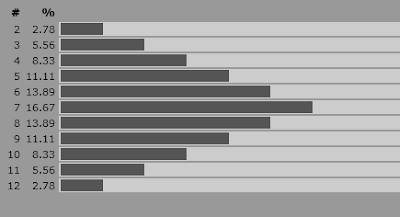The probabilities of Maze Rats and Kallt Järn Hack 0.1
The probabilities of Maze Rats
I'm not a fan of big numbers. Furthermore, I'm not a fan of doing math when doing checks. When the survival of your PC depends on a dice roll, I often find that calculation gets in the way of narrative oomph.
Maze Rats by Ben Milton has quickly become one of my favorite systems for this reason. Only 3 attributes. Target number for saves is always 10. Attack roll - armor = damage. However, I'm less sure about the 2d6. Yes, it gives you a probability distribution closer to a normal distribution, but it becomes harder for a player to understand the probability of hitting a certain value.
This trade off makes sense for games with outcomes other than just succeed or fail, like the Powered by the Apocalypse games. A central feature in those games is to have the "yes, but" outcome remain likely regardless of the PC:s attribute value. In Maze Rats it looks to me like an unnecessary complication. It also has the consequence of each stat up in the same attribute being more valuable than the last. Given a DC of 10, Going from 2 to 3 in an attribute gives you an additional 16.67% probability of success, while going from 0 to 1 gives you +11.11%. However, this only continues until you hit +3 in an attribute, after which the returns on additional stat-ups diminish. This is not obvious, which might fit a game where math is part of the fun. I don't think this is part of the Maze Rats ethos though.
 |
| The possible values and the probabilities of hitting them when rolling 2d6, courtesy of anydice.com |
 |
| The probability of getting a 10 or higher for possible attribute values in Maze Rats, also calculated with anydice.com |
This also has an impact on damage when attacking. Generally, it means that low damage numbers are more likely and high damage numbers become unlikelier the higher they are. This is a pretty cool feature, but again, not very obvious.
We can look at the average damage of an attack, given armor, weapon damage, and attack bonus. Attack bonus and armor cancel out, so +1 AB vs +1 armor = +0 AB vs no armor. Below you can see the average damage given a value of AB - armor. Misses are accounted for as hits causing 0 damage. You can play around with this at https://anydice.com/program/230cf.
 |
| Average damage of an attack with a +0 light weapon in Maze Rats for values of AB - armor between -2 and 4. |
Like with the danger roll probabilities, we see that we get increasing returns from each AB increase. Interesting, but not obvious.
A "stream of conciousness" design process of Kallt Järn Hack 0.1
- So lets keep Strength, Dexterity and Will/Presence.
- Exchange the 2d6 for a d10.
- Attributes start at 2, 3 and 4.
- Roll under to save. Probability of success is now X in 10. Clean.
- Advantage and disadvantage is rolling twice and taking the best or worst outcome.
- Roll under Violence (starting at 5) to hit.
- The value on the die + Weapon Damage is your attack damage. You hope for a value as high under your Violence-stat as possible.
- Armor lets you ignore damage lower than your armor value. Leather is 3, chain 4, plate 5.
Sneaky geometric damage progression
This bit with the damage and armor is the least obvious here I'm afraid. Let me illustrate with a lil graph.
Armor as damage soak
- Armor N soaks N damage from each hit. Armor 1 is light, 2 is heavy.
- Weapons can have an additional Weapon Damage Bonus. Heavy weapons add +1 damage after hit.
The average damage a weapon adds is just Violence * WDB / 10, so a Violence 5 peasant wielding a claymore ups their damage output from 1.5 to 2. This makes heavy weapons more valuable to higher skilled fighters, which feels cool.






Comments
Post a Comment